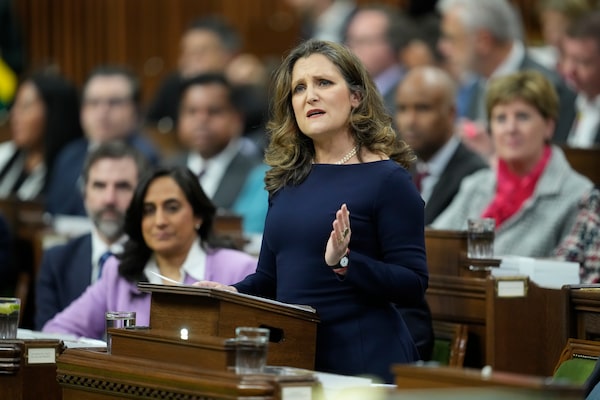
Finance Minister Chrystia Freeland deliveres the federal budget in the House of Commons in Ottawa on April 16.Adrian Wyld/The Canadian Press
In her budget speech this month, Finance Minister Chrystia Freeland pointed to 1980s-era tax changes by the Progressive Conservative government of Brian Mulroney as a precedent for boosting the tax take on capital gains.
“Prime Minister Brian Mulroney raised the capital-gains inclusion rate to 75 per cent – higher than the rate we’re establishing today,” she said.
If one were to leave it at that, the Liberals come off quite well, having decided to boost the inclusion rate for capital gains – the amount subject to tax – to two-thirds, well below that of the latter years of the Mulroney government.
But Ms. Freeland was only telling half the story. The Mulroney government did raise the capital-gains inclusion rate, in two steps, to 75 per cent from 50 per cent. But that action was just one element of a broad tax reform that also included cuts to the corporate tax rate and top personal income tax rates, and a generous exemption for capital gains.
The Liberals have headed in the opposite direction, starting in 2016 with an increase in the marginal tax rate for individuals with a taxable income of $200,000 or more. The Trudeau government hasn’t increased the broad corporate tax rate, but it has targeted sectors with so-called windfall taxes. So this month’s changes to the inclusion rate for capital gains feeds into a higher tax rate for higher earning individuals – an increase on top of an increase.
The result is a bigger tax bite on capital gains: $19.4-billion over five years for the federal government, with a $6.9-billion spike this fiscal year. On top of that, Ottawa estimates that the provinces and territories will reap as much as 60 per cent of its own total, up to an additional $11.6-billion. All told, individuals and corporations could be handing over as much as an extra $31-billion in the coming half-decade.
Without the $6.9-billion windfall, Ms. Freeland would have had to rein in $17.2-billion in program-spending increases in fiscal 2024-25. The Liberals aren’t trying to improve the tax system; they are plugging a hole in the budget.
It is true that the changes proposed by the Liberals do equalize the tax treatment of dividends and capital gains. That’s an important principle of tax policy − the idea of a “buck is a buck,” and that tax considerations should not distort investment decisions, notes University of Calgary economics professor Trevor Tombe. On that narrow basis, increasing the capital-gains inclusion rate makes some sense.
But levelling the playing field does not mean it has to be levelled up. As was the case in the 1980s, the Liberals could have boosted the inclusion rate for capital gains but then cut the tax rates applied to those gains for individuals and corporations. Prof. Tombe notes that, had the Liberals taken a revenue-neutral approach, they would have been able to cut the top personal income tax rate by four percentage points – rolling back their 2016 hikes.
The Liberals have gone to great pains to portray the capital-gains changes as a tax paid by the ultrawealthy, saying just 40,000 Canadians with an average gross income of $1.4-million would be affected. In other words: not your problem, middle-class Canada.
That assertion glosses over a couple of important facts, however. First, the intimation that the bigger capital-gains tax bite is linked to a seven-digit income is largely a red herring. The underlying income of anyone with capital gains doesn’t affect their exposure to the higher inclusion rate. A person selling a family cottage where the individual capital gains exceeded $250,000 will pay more in taxes, even if they have a middle-class income.
More broadly felt will be the second-hand effect from higher capital-gains taxes on corporations. Shareholders (both individuals and pension plan funds) will feel that pinch, indirectly.
There is another basic principle of taxation policy: Whatever you tax, contracts. Higher tobacco taxes mean fewer cigarettes will be bought, for instance – a point Ms. Freeland’s budget makes in hiking excise taxes.
What’s true for smokes is true for investment: increased capital-gains taxes will be a disincentive. Given Canada’s deepening productivity woes, it is precisely the wrong policy.
There is a thoughtful plan that would create a level playing field for investment capital, iron out distortions and galvanize private-sector growth – as the Mulroney Tories did in the 1980s. The Liberal tax hike, designed to pay for a spending spree, instead punishes prosperity.